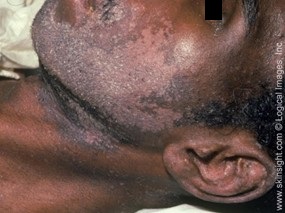Seborrheic dermatitis
Sarah Lee, BA and Roopal V. Kundu, MD

Temporary lightening of skin due to seborrheic dermatitis.
Seborrheic dermatitis is traditionally characterized by redness, itching, and greasy flaking of the skin. In patients of color, affected areas may be lighter in color than the surrounding skin and may have no redness. These patches occur in areas containing many oil glands, most commonly on the scalp, face, ears, chest, and in skin folds. Dandruff is considered to be a mild form of seborrheic dermatitis.
Who does seborrheic dermatitis affect?
Seborrheic dermatitis is a common disorder that affects people of all ages and skin types. It is more common in older adult men and may be more common in African-Americans.1 People with Parkinson’s disease,2 eating disorders,3 stroke, congestive heart failure,4 epilepsy, zinc deficiency, a history of chronic alcoholism, obesity,5 or mood disorders6 are more likely to develop seborrheic dermatitis than the general population. Nearly all AIDS patients (90-95%) develop this condition4 In infants, seborrheic dermatitis of the scalp is called “cradle cap.”
What is the cause of seborrheic dermatitis?
The cause of seborrheic dermatitis is unknown, but the condition is linked to the skin’s overproduction of oil and an overgrowth of a normally harmless skin yeast called Malassezia.
Seborrheic dermatitis symptoms may be worsened by heat,6 illness, irritation, some medications,4 cold and dry environments,5 and stress. As mentioned previously, certain diseases are associated with higher rates of developing seborrheic dermatitis.
How do I know if I have seborrheic dermatitis?
Scaling of the skin on the scalp, eyebrows, forehead, ears, and beard area is typical. Some cases may also involve the central chest, underarms, groin, and around the belly button. In darker skinned patients, this scaling can have a flower-like shape (thus the term petaloid seborrheic dermatitis). Discoloration of the skin with lightening or darkening of affected areas may also occur. It is sometimes itchy. A dermatologist can determine if you have seborrheic dermatitis by clinical examination. In rare cases, a skin scraping or biopsy may be necessary to confirm the diagnosis or to rule out other explanations for your symptoms.
What are the best treatments for seborrheic dermatitis?
In infants, seborrheic dermatitis self-resolves with gentle skin care (i.e., moisturizers), though topical steroids or topical antifungals may be used in severe cases. In adults, however, seborrheic dermatitis tends to be chronic. There is no cure thus the goal is to control the rash and associated symptoms. Treatments include anti-fungal shampoos and creams, topical anti-inflammatory agents, and topical steroids. The selected treatment must be used regularly in order to effectively control seborrheic dermatitis. The treatment schedule and combination of medications your doctor prescribes to you will depend on the severity of your symptoms, the location of disease, and your hair and skin type. Many treatments for seborrheic dermatitis are available over the counter including medicated shampoos (e.g., ketoconazole, zinc pyrithione, selenium sulfide, salicylic acid, and tar) and low-strength topical steroids. Some cases of seborrheic dermatitis require prescription medications in order to obtain satisfactory improvement. Pigmentary changes associated with seborrheic dermatitis typically improve with treatment.
Download Spanish translation.
Descarga traducción en español.
References:
1. Kelly, A. P., Taylor, Susan (2009). Dermatology for Skin of Color, McGraw-Hill Professional.
2. Mandell, G. L., Bennett, John E., Dolin, Raphael (2009). Principles and Practice of Infectious Diseases, Churchill Livingstone.
3. Strumia, R. (2005). “Dermatologic Signs in Patients with Eating Disorders.” American Journal of Clinical Dermatology 6(3): 165-173.
4. Selden, S. (2010). “Seborrheic Dermatitis: Follow-up.” eMedicine from WebMD. : https://emedicine.medscape.com/article/1108312-overview
5. Berman, K. (18 Jul 2007). “Seborrheic Dermatitis.” MedlinePlus.
http://www.nlm.nih.gov/medlineplus/ency/article/000963.htm
6. Bolognia, J. L., Jorizzo, Joseph L., Rapini, Ronald P. (2007). Dermatology, Mosby.

Cutis Journal
Read published peer-reviewed articles written your by Skin of Color Society members

Did You Know
Skin of color patients comprise the majority in California, New Mexico and Texas…and soon will be the majority in Arizona, Nevada, Georgia, New York and Florida.
By 2042, more than 50% of the US population will have skin of color.




